月形町須部都川の視察レポート
月形町須部都川を見てきました
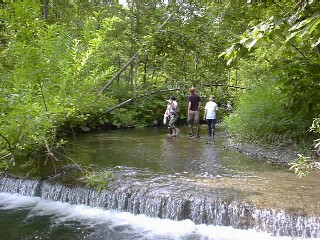
- まとめ作成者 ニセコ町役場企画環境課環境衛生係
- 日時 平成14年7月30日(火)
- 場所 月形町須部都川上流部低ダム群施工地
| 指導 | 東三郎さん(森林空間研究所) 妹尾優二さん(エコテック) |
|---|---|
| 協力 | 月形町役場 後藤敏志さん |
| 参加者 | ・宮田文子さん(環境を考える会代表) ・森俊昭さん、森山繁夫さん、池田郁郎さん ・尾潟直美さん(ニセコ町) ・伊藤久由さん(虻田町) ・梅田滋さん(コミュニティ研究所) ・河村美知子さん(コミュニティ研究所) ・河村結生さん(東北大学学生) ・水正貞教さん(森林再生技術研究所、低ダム群施工当時の営林署担当者) ・斉藤順一さん(空知森林管理署樺戸治山事業所) ・平川全機さん(北海道大学大学院) |
最初に訪れた場所は、支流ポン須部都川で、川のカーブした場所に落差約60cmの低ダムが3基設置されていました。この場所には、東先生が植えたエゾミソハギの花が咲いているほか、柳などの低木や多くの草も生えてきており、河岸が安定している様子がうかがえました。
先生によると子供が遊べるような場所にしたかったとのことです。
水量は非常に少なく、水温は高めで、トビケラ類などの水生昆虫とウグイが観察されました。
次に須部都川本流の低ダム群施工地を訪れました。車を降り、川に沿った道を下流へ歩き、施工地の最下流から上流に向かって川の中を歩き、川の様子を観察しました。
先生によると子供が遊べるような場所にしたかったとのことです。
水量は非常に少なく、水温は高めで、トビケラ類などの水生昆虫とウグイが観察されました。
次に須部都川本流の低ダム群施工地を訪れました。車を降り、川に沿った道を下流へ歩き、施工地の最下流から上流に向かって川の中を歩き、川の様子を観察しました。
低ダム群の設置により育成した森
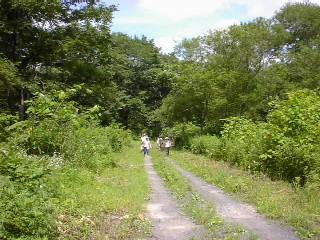
下流に向かう途中に歩いた場所は、柳をはじめ、ハンノキ類、ハルニレなどの森となっていました。この場所は25年前の低ダム群施工以前には、森などはない、一面の荒地だったとのことです。低ダム群の設置により、土地が安定し、この状態まで森が育ったということです。
東先生の説明では、多くの人が勘違いしていることですが、「森があるから土地が安定している」のではなく、「安定した土地だから森ができる」ということでした。
低ダム群の最下流部は、上流の低ダム群により、土砂の供給がなくなったために、ひどい河床低下をおこしていたため、平成10年に新たに低ダム群を設置して、最下流の1基は自然の岩盤に擦り付けることで、河床低下を防ぎ、落差を低く抑えることで、魚の移動を妨げないように工夫されています。 低ダム群の直下は、1m程度の水深があり、他の部分よりも深くなっています。そのすぐ下流には土砂が堆積して20cm程度の水深となっています。低ダムにより、水の流れがコントロールされて土砂の移動を抑えているのがわかります。また、この働きによって、直線方向での瀬、淵の連続構造が構成されています。
ダム直下には、十分な水深があり、落差も低いことから、低ダムの魚類の移動に対する影響は少ないようです。また、平成10年に設置されたものは、下流側を斜めに切ってあり、魚が移動しやすいように配慮されています。
東先生の説明では、多くの人が勘違いしていることですが、「森があるから土地が安定している」のではなく、「安定した土地だから森ができる」ということでした。
低ダム群の最下流部は、上流の低ダム群により、土砂の供給がなくなったために、ひどい河床低下をおこしていたため、平成10年に新たに低ダム群を設置して、最下流の1基は自然の岩盤に擦り付けることで、河床低下を防ぎ、落差を低く抑えることで、魚の移動を妨げないように工夫されています。 低ダム群の直下は、1m程度の水深があり、他の部分よりも深くなっています。そのすぐ下流には土砂が堆積して20cm程度の水深となっています。低ダムにより、水の流れがコントロールされて土砂の移動を抑えているのがわかります。また、この働きによって、直線方向での瀬、淵の連続構造が構成されています。
ダム直下には、十分な水深があり、落差も低いことから、低ダムの魚類の移動に対する影響は少ないようです。また、平成10年に設置されたものは、下流側を斜めに切ってあり、魚が移動しやすいように配慮されています。
低ダム間に育った河畔林
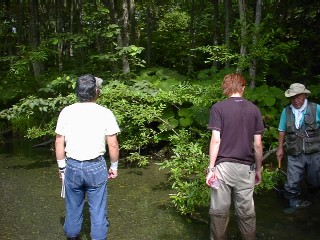
低ダムの間では、川の両岸に堆積した土砂の上に河畔林が形成され、川幅は自然の働きによって水量に対して必要最低限の幅まで狭くなり、自然河川の環境に近い状態となっています。
また、河岸から川に倒れこんだ倒木などにより、淵が形成されたり河畔林の根の下がえぐれて、奥行き30cm程度のカバーが形成されるなど、魚の生息には適した空間が形成されていました。
実際、川を歩いていると、多くの魚をみかけ、ウグイやドジョウを捕まえることもできました。
また、河岸から川に倒れこんだ倒木などにより、淵が形成されたり河畔林の根の下がえぐれて、奥行き30cm程度のカバーが形成されるなど、魚の生息には適した空間が形成されていました。
実際、川を歩いていると、多くの魚をみかけ、ウグイやドジョウを捕まえることもできました。
底質のためか水生昆虫があまりみられませんでした
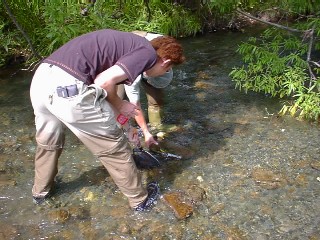
しかし、水生昆虫はとても少なく、魚が生息するためには、餌となる水生昆虫が少なすぎるとのことでした。原因としては、河床の質が玉砂利ではなく、細かい砂が多いことが考えられます。
川底には砂がたくさんたまっています
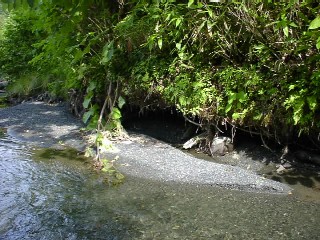
東先生の説明では、山の地質上、細かい砂が多いのは仕方ないとのことです。低ダム群は土砂を堆積するためのものですから、その働きで通常よりも多く砂を溜め込んでいるという可能性も考えれらるため、他の河川へ応用する場合には、山の地質や上流部の土砂移動の特徴など、流域全体の状況を総合的にみて、施工法や場所を考えるなど、注意する必要がありそうです。
記念植樹と記念撮影
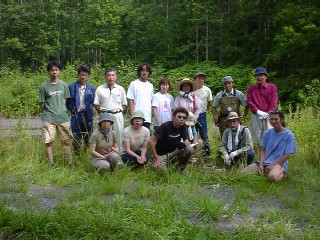
視察の最後に、カミネッコンを使った記念植樹をして、解散しました。
参加者からいくつかの疑問が出されましたが、低ダム群は、土砂の動きをうまくコントロールし、河岸の崩壊を防ぎ、河川周辺の森林を再生できることが、須部都川で実証されているので、有効性は大変高いものです。また、生態系は時間軸の中で絶えず変化していくものですから、施工前に植物が全くなかった場所が、25年ほどの時間をかけて、このような姿になったこと、そして、今後も変化を続けていくことを考えることが必要です。
また、東先生の指摘では、低ダム群は、現状のような重厚なコンクリートを使う必要はなく、石や丸太を使った簡易な施工で十分に機能するとのことでした。このような方法であれば、小規模な川では、住民が自ら改修作業をすることができ、住民参加の河川改修計画、河川改修工事を実現できる可能性もあります。
今後は、安い経費で、環境への負荷が少なく、住民が自ら行動できる、こうした河川改修を導入する必要があるのではないでしょうか。
今回、視察した須部都川は、川の規模はニセコ町を流れるルベシベ川と同じですが、周辺に農地や宅地がないこと、生息している魚がニセコに多く見られるような鮭科の魚ではないことなどの違いがあり、須部都川の低ダム群をそのまま導入した方がいいかどうかについては、今後、議論が必要だと思われます。しかし、須部都川の事例から考えると、低ダム群と遊水地、遊砂地をうまく組み合わせることで、農地の隣接する川でも、水害による被害を十分に抑えることができるのではないでしょうか。
いずれにしても、川に要求される全ての条件を100%満たすのは、非常に難しいことです。それぞれの要求を可能な限り満足できる方法を考えると同時に、どの部分にどれだけ重点をおくのかということを、議論し決定していくことが大切です。
また、治水対策とは、単に河川内を工事し河道断面積を確保すればいいということではなく、地域の住民の生活スタイル、土地利用、また、流域全体の生態系、川を訪れて、親しみ、利用する人の考え方など、いろいろなことを総合的に考えなければなりません。
次の世代に大切な財産を残すため、十分な議論が求められます。
参加者からいくつかの疑問が出されましたが、低ダム群は、土砂の動きをうまくコントロールし、河岸の崩壊を防ぎ、河川周辺の森林を再生できることが、須部都川で実証されているので、有効性は大変高いものです。また、生態系は時間軸の中で絶えず変化していくものですから、施工前に植物が全くなかった場所が、25年ほどの時間をかけて、このような姿になったこと、そして、今後も変化を続けていくことを考えることが必要です。
また、東先生の指摘では、低ダム群は、現状のような重厚なコンクリートを使う必要はなく、石や丸太を使った簡易な施工で十分に機能するとのことでした。このような方法であれば、小規模な川では、住民が自ら改修作業をすることができ、住民参加の河川改修計画、河川改修工事を実現できる可能性もあります。
今後は、安い経費で、環境への負荷が少なく、住民が自ら行動できる、こうした河川改修を導入する必要があるのではないでしょうか。
今回、視察した須部都川は、川の規模はニセコ町を流れるルベシベ川と同じですが、周辺に農地や宅地がないこと、生息している魚がニセコに多く見られるような鮭科の魚ではないことなどの違いがあり、須部都川の低ダム群をそのまま導入した方がいいかどうかについては、今後、議論が必要だと思われます。しかし、須部都川の事例から考えると、低ダム群と遊水地、遊砂地をうまく組み合わせることで、農地の隣接する川でも、水害による被害を十分に抑えることができるのではないでしょうか。
いずれにしても、川に要求される全ての条件を100%満たすのは、非常に難しいことです。それぞれの要求を可能な限り満足できる方法を考えると同時に、どの部分にどれだけ重点をおくのかということを、議論し決定していくことが大切です。
また、治水対策とは、単に河川内を工事し河道断面積を確保すればいいということではなく、地域の住民の生活スタイル、土地利用、また、流域全体の生態系、川を訪れて、親しみ、利用する人の考え方など、いろいろなことを総合的に考えなければなりません。
次の世代に大切な財産を残すため、十分な議論が求められます。
参加者からの感想、意見
参加者を代表して、宮田さん、池田さん、伊藤さんから、須部都川の低ダム群視察に関する感想、疑問点などを伺いました。
- 水生昆虫がほとんど見られなかった。水質の問題でなければ、底質が砂地になっていることが挙げられる。水質には、問題はなさそう。
- 昔はイワナが生息していたという話。
- 生命感が感じられない。
- 流入河川の水はきれいなのに、なぜ、ダムの水がひどく濁っているのか。
- ルベシベ川の場合も、現在の砂防ダムの砂の堆積状況を見ると、低ダム群の設置によって河床に砂が堆積する可能性がある。
- 低ダム群の施工により、水の流れが広がり、流れがフラットになりすぎている。魚類の移動などに支障がある。
- 低ダム群で、流れが浅く広くなってしまうことで、水温が上昇することも考えられる。
- 普段の生活では、なかなか見たり聞いたりすることができない経験だったので、よかった。
- 「(低ダム群工法のことを)町の人に聞いてもわからない」という先生の言葉が印象的だった。国や道でやる事業は地元の人には伝わっていないことを実感した。ニセコでは川の工事をする場合などは、町の事業でなくとも、地域や町民で考える機会をつくってほしい。
- 子どもが遊ぶようにと作った場所を訪れたが、実際に町民がほとんど知らない状況で、本当に子どもが遊んでいるのかという疑問をもった。
- 見た目はきれいだが、川の流れに変化がなく、自然中心の川づくりではないのだろうと思った。
- 同じ川を見ても、人によっていろいろな視点があり、いろいろな話を聞けたのでよかった。
- 子どもたちが、どのように感じるのかを聞いてみたい。
- 須部都川の勾配は25%ということで、ニセコの河川に応用する場合、どの程度の河川まで利用できるのかが気になった。ニセコにはなだらかな川が非常に少ない。
- 先生の説明では、コンクリートの必要がなく、丸太などの木を利用しても十分に機能するということだったので、コンクリートによる施工ではなく、木を使った事例を見てみたかった。
- コンクリートのように、現地にある以外の物質を使って施工するのはいかがなものかと思う。
- 従来のような高い砂防ダムよりは、ずっといい。
- 植生はニセコとほとんど同じ。観察された約150種類の植物のうち、ニセコで見られないものは3種類(ドクウツギ、オオバギボウシ、ヒメドクサ)しかなかった。
- 低ダム群工法は、植生に対して悪影響を与えることは、ほとんど考えられない。
- 工事や事後の植林などにより、外来種が入ってしまうことに問題がある。施工にあたっては、できるだけ土を遠くから持ち込まないなど、外来種移入を最小限におさえるための工夫が必要。
- 河床に砂が多くたまっているのが気になった。
- 谷が狭いわりに、傾斜が緩やかな、ニセコでは見られない珍しい地形。
- 施工地の森に柳が多く見られたが、最初はしかたのないこと。今後、土地が乾いてくることで、ハルニレなどが増えてくると思われる。
- 土砂の堆積のしかたが、少し不自然な感じがした。
平川全機さんからの意見
須部都川の視察に参加した平川全機さんは、今回の視察だけでなく、これまで見聞きしたことを含めた感想として、次のような意見を寄せています。
聞取りなどをして感じていることなどですが、現状を必ずしも良いと考えていない。しかし、河川改修などのように自然に手を加えるともっと悪くなってしまうのではという危惧があるように思います。
一つは、これまでの工事がそうだったためでしょうし、もう一つは工事の後、回復するのを待てないということがあると思います。
低ダム群工法でも、コンクリートで作れば(倒木などでもいいそうですが)一旦は河床に手を入れることになりますし、人工的な構造物がいくつも現われるのはやはり抵抗を覚える人もいるのかなと思いました。
とある川では、落差工に強い抵抗が住民にあるので、例え有効でも受け入れられないだろうと思いました。生態系にとって良い川と住民が良いと選び取る川の形は違っていると感じています。
聞取りなどをして感じていることなどですが、現状を必ずしも良いと考えていない。しかし、河川改修などのように自然に手を加えるともっと悪くなってしまうのではという危惧があるように思います。
一つは、これまでの工事がそうだったためでしょうし、もう一つは工事の後、回復するのを待てないということがあると思います。
低ダム群工法でも、コンクリートで作れば(倒木などでもいいそうですが)一旦は河床に手を入れることになりますし、人工的な構造物がいくつも現われるのはやはり抵抗を覚える人もいるのかなと思いました。
とある川では、落差工に強い抵抗が住民にあるので、例え有効でも受け入れられないだろうと思いました。生態系にとって良い川と住民が良いと選び取る川の形は違っていると感じています。
須部都川の視察に参加した平川全機さんは、今回の視察だけでなく、これまで見聞きしたことを含めた感想として、次のような意見を寄せています。
聞取りなどをして感じていることなどですが、現状を必ずしも良いと考えていない。しかし、河川改修などのように自然に手を加えるともっと悪くなってしまうのではという危惧があるように思います。
一つは、これまでの工事がそうだったためでしょうし、もう一つは工事の後、回復するのを待てないということがあると思います。
低ダム群工法でも、コンクリートで作れば(倒木などでもいいそうですが)一旦は河床に手を入れることになりますし、人工的な構造物がいくつも現われるのはやはり抵抗を覚える人もいるのかなと思いました。
とある川では、落差工に強い抵抗が住民にあるので、例え有効でも受け入れられないだろうと思いました。生態系にとって良い川と住民が良いと選び取る川の形は違っていると感じています。
聞取りなどをして感じていることなどですが、現状を必ずしも良いと考えていない。しかし、河川改修などのように自然に手を加えるともっと悪くなってしまうのではという危惧があるように思います。
一つは、これまでの工事がそうだったためでしょうし、もう一つは工事の後、回復するのを待てないということがあると思います。
低ダム群工法でも、コンクリートで作れば(倒木などでもいいそうですが)一旦は河床に手を入れることになりますし、人工的な構造物がいくつも現われるのはやはり抵抗を覚える人もいるのかなと思いました。
とある川では、落差工に強い抵抗が住民にあるので、例え有効でも受け入れられないだろうと思いました。生態系にとって良い川と住民が良いと選び取る川の形は違っていると感じています。
札幌市在住の坂本純科さんからの感想
須部都川視察の内容を伝え聞いた、札幌市在住の坂本純科さんから、次のような感想が寄せられています。
非常に面白い話ですね。
生態系というのはバランスの問題だけでなく、どのくらいのスパンとエリアで考えるべきか、という問題があって、なかなか簡単には結論を出すことができないテーマだと思います。
もしかしたら50年は実験期間としては短いのかもしれないし・・・。市民も行政も長期で粘り強く試行錯誤していくことが必要ですよね。今の行政システムでは致命的に欠けている部分だろうし、市民側も反対運動では盛り上がっても長期的な取り組みは苦手かも・・。
非常に面白い話ですね。
生態系というのはバランスの問題だけでなく、どのくらいのスパンとエリアで考えるべきか、という問題があって、なかなか簡単には結論を出すことができないテーマだと思います。
もしかしたら50年は実験期間としては短いのかもしれないし・・・。市民も行政も長期で粘り強く試行錯誤していくことが必要ですよね。今の行政システムでは致命的に欠けている部分だろうし、市民側も反対運動では盛り上がっても長期的な取り組みは苦手かも・・。
コミュニティ研究所梅田さんからのコメント
ニセコ町環境基本計画の策定にも協力をいただいた、コミュニティ研究所の梅田さんも、今回の視察に参加したので、コメントをいただきました。
7月30に行われた須部都川上流域における低ダム群工法の視察において、いくつかの疑問が指摘されました。これらの疑問点について、若干の整理を試みたいと思います。
《指摘された問題点》
1)低ダム群の河床部分は砂利などが広がっており、水生昆虫もあまり観察されなかった。生息している魚類もその種類は少なく、水生生物の生息環境として若干の疑問を感じる。
2)上流部の山林の中では効果的な工法であることは理解できたが、広い河川敷が必要なことなどの点で、中流域の農地を流域とする川の場合に適しているかどうか、不安がある。
3)現場で工法の説明を聞いてもなかなかピンとこない人も少なからずいた。工法の原理は、やっぱりわかりにくい印象がある。多くの町民に理解できるかどうか心配だ。
《問題点についての私感》
1)について
低ダム群工法の大きな特徴は、治水機能と生態系回復機能の両立にあります。暴れ川の砂防機能が主たる目的ではありますが、その機能の副産物として河川の両側に土砂を安定的に堆積させ、そこに河畔林が進出して氾濫原にミズナラなど安定した樹種まで生えるようになります。また、土砂が両サイドに振り分けられることで流筋が定まり、河畔林から落ちる虫なども加わって魚類の生息を誘発する、という生態系が時間の経過の中で回復してきます。視察ポイントの河床に水生昆虫があまりいなかった、という問題点が現状には認められるようですが、砂礫や泥土などが堆積するようになって一層豊かな生息環境になるかどうか、今後の観察課題ではないかと思います。ただ、視察ポイントは、月形ダムの上流部なので、海などからの回遊魚が遡上できない(妹尾さんの下記のレポートによると、スナヤツメ、エゾウグイ、フクドジョウ、ハナカジカの4科4種が生息。視察当日はヒメマス(?)も観察されました。)など、構造的な制約条件も原因のひとつではないか、とも思います。いずれにしても、生態系は時間軸の中で変わるものです。生態系の現状を変化しないものとして固定的に捉えるのではなく、どのように変化するのか想像してみる必要があると思います。
大切な視点は、いくつかの機能の中でそれぞれの機能が全て百%満たされることができない場合、どの機能をどの程度重視するのか、ということではないか、と思います。暴れ川の場合、治水機能は無視できません。つまり、自然河川のまま放置することができない社会的要請がある場合、自然生態系をどのような状況にどの程度保全するのか、回復するのか、ということではないかと思います。
(須部都川の低ダム群ポイントにおける水生生物の生態系の実態については、妹尾優二さんの調査報 告書『低ダム群工法と魚類生息-石狩川地区民有林直轄治山事業-』が参考になります。この報告 書によると、いくつかの課題は残っているものの、淵の形成によって"稚魚にとっては格好な生息場所となっている"(4頁)と評価されています。)
2)について
低ダム群の適したポイントは、河川敷地が広くとれる場所です。これは、上流の山中でも、中流の農業地帯でも同じでしょう。ルベシベ川を例にすると、周辺の農地との間の河川敷に余裕があるところが、低ダム群の設置候補地でしょう。実際の効果については、現地でのワークショップで検討する必要があると言えます。
3)について
今後現地で行うワークショップで、どのような手法を試みるのか、という課題と思います。東先生の話を聞いても、水正さんや妹尾さんの説明を聞いても、わかりにくさは確かに残ります。それが、低ダム群の普及率の低さの原因になっているのかもしれません。しかし、川の中に入って流れの圧力や流路の変化を体験することで、納得がいくのかもしれません。どのようなワークショップにするのか、これから相談しながら、ということではないでしょうか。
7月30に行われた須部都川上流域における低ダム群工法の視察において、いくつかの疑問が指摘されました。これらの疑問点について、若干の整理を試みたいと思います。
《指摘された問題点》
1)低ダム群の河床部分は砂利などが広がっており、水生昆虫もあまり観察されなかった。生息している魚類もその種類は少なく、水生生物の生息環境として若干の疑問を感じる。
2)上流部の山林の中では効果的な工法であることは理解できたが、広い河川敷が必要なことなどの点で、中流域の農地を流域とする川の場合に適しているかどうか、不安がある。
3)現場で工法の説明を聞いてもなかなかピンとこない人も少なからずいた。工法の原理は、やっぱりわかりにくい印象がある。多くの町民に理解できるかどうか心配だ。
《問題点についての私感》
1)について
低ダム群工法の大きな特徴は、治水機能と生態系回復機能の両立にあります。暴れ川の砂防機能が主たる目的ではありますが、その機能の副産物として河川の両側に土砂を安定的に堆積させ、そこに河畔林が進出して氾濫原にミズナラなど安定した樹種まで生えるようになります。また、土砂が両サイドに振り分けられることで流筋が定まり、河畔林から落ちる虫なども加わって魚類の生息を誘発する、という生態系が時間の経過の中で回復してきます。視察ポイントの河床に水生昆虫があまりいなかった、という問題点が現状には認められるようですが、砂礫や泥土などが堆積するようになって一層豊かな生息環境になるかどうか、今後の観察課題ではないかと思います。ただ、視察ポイントは、月形ダムの上流部なので、海などからの回遊魚が遡上できない(妹尾さんの下記のレポートによると、スナヤツメ、エゾウグイ、フクドジョウ、ハナカジカの4科4種が生息。視察当日はヒメマス(?)も観察されました。)など、構造的な制約条件も原因のひとつではないか、とも思います。いずれにしても、生態系は時間軸の中で変わるものです。生態系の現状を変化しないものとして固定的に捉えるのではなく、どのように変化するのか想像してみる必要があると思います。
大切な視点は、いくつかの機能の中でそれぞれの機能が全て百%満たされることができない場合、どの機能をどの程度重視するのか、ということではないか、と思います。暴れ川の場合、治水機能は無視できません。つまり、自然河川のまま放置することができない社会的要請がある場合、自然生態系をどのような状況にどの程度保全するのか、回復するのか、ということではないかと思います。
(須部都川の低ダム群ポイントにおける水生生物の生態系の実態については、妹尾優二さんの調査報 告書『低ダム群工法と魚類生息-石狩川地区民有林直轄治山事業-』が参考になります。この報告 書によると、いくつかの課題は残っているものの、淵の形成によって"稚魚にとっては格好な生息場所となっている"(4頁)と評価されています。)
2)について
低ダム群の適したポイントは、河川敷地が広くとれる場所です。これは、上流の山中でも、中流の農業地帯でも同じでしょう。ルベシベ川を例にすると、周辺の農地との間の河川敷に余裕があるところが、低ダム群の設置候補地でしょう。実際の効果については、現地でのワークショップで検討する必要があると言えます。
3)について
今後現地で行うワークショップで、どのような手法を試みるのか、という課題と思います。東先生の話を聞いても、水正さんや妹尾さんの説明を聞いても、わかりにくさは確かに残ります。それが、低ダム群の普及率の低さの原因になっているのかもしれません。しかし、川の中に入って流れの圧力や流路の変化を体験することで、納得がいくのかもしれません。どのようなワークショップにするのか、これから相談しながら、ということではないでしょうか。
妹尾優二さんからのコメント
妹尾優二さんは、魚類をはじめとする河川生態系の専門家であり、河川改修のコンサルタントも行っています。また、過去に須部都川の生態調査も行っています。 今回の視察に同行していただき、参加者の感想などに対して、専門的な立場からコメントをいただきました。
砂の堆積について
これからの新しい川づくりについて
砂の堆積について
- 低ダム群は、そもそも土砂をためるためのもの。結果として、上流から流れてきた砂が堆積した形となっている。
- 低ダム群によりまっ平らな川になっている。これにより、流速がゆるく一定になってしまっていることで、砂だけがたまることにつながっているのではないか。流れに変化をつけることで、砂と石をうまく分離できる。
- 5年前には、もっと大きな玉石がごろごろしていた。もしかしたら、上流部の工事などによって砂が流れ込み堆積したのではないか。
- 山の地質上、水質があまりよくないため、イワナなどはもとから生息していなかったのではないか。
- 低ダム群のように水面が広く浅くなることで、水温は上昇する。
- 倒流木を除去したために、流れが一様になってしまった。
これからの新しい川づくりについて
- 平水時と洪水時の水の流れを分けて考えた、河道計画が必要。
- 流れに変化をつける方法
- 洪水から平水に戻るときに、河道が形成される。このときに、変化に富んだ流れになるように、きっかけを与える。
- ルベシベ川では、左岸がほとんど山にくっついている。これをうまく利用して河道の計画をつくれないか。
- 既存の植物を守るために、河道を矯正してはいけない。柳などは、氾濫源にあっというまに生えてくる。
- 平水時には、水衝部に思いっきり水がぶつかってもよい。大きな倒木や、木工沈床などで河岸を保護するとよい。ただし、洪水時にはその部分が洗堀されないような水の流れをつくるような河道設計が必要。
- 部分的に、低ダム群の考えを応用して河床全体の低下を防ぐ。
- 現在の改修工事では河道断面が一様で、流量が多くなると流速も速くなり、河床が一様に洗堀されるため、河床低下を招く結果となっている。状況に応じて流速をコントロールする設計が必要。
- 川の中には洗堀される場所もあってよい。そうした場所で水のエネルギーが吸収されるため、下流側には堆積される。
- 留萌管内の小平蘂(オビラシベ)川というところで、実際にこの考えで施工したところ、よい結果が得られたが、その上流部を従来のやり方で改修してしまったために、現在はひどい土砂の堆積がみられるようになってしまった。
- 純粋な自然の河川のあり方を手本として、河道の設計をする必要がある。
- 自然河川は、氾濫はするが決壊することはない。人工的に手を加えることにより様々な問題がおこってくる。
東先生からのコメント
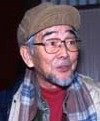
東先生は、低ダム群工法の発案者で、今回視察した須部都川の低ダム群の設計もしています。参加者のみなさんからの声に対して、コメントをいただきました。
「須部都川視察の感想など拝読して」
自然観は、人それぞれであって、画一化することはできないし、個人的見解を押し付ける必要もない。しかし公共投資となれば合意に達するような論理が求められる。分業化社会で各専門分野の論理を繋ぎ合わせようとすると、時間オーダーと空間スケールが違っているから、議論はかみ合わずもどかしいものがある。
治水と利水は河川管理者の論ずるところであり、30年、50年、100年確率の豪雨を基準に設計し施工されている。地質学は数万年、数百万年のオーダーで地下深部の構造を論じている。砂防学はせいぜい100年以内のテクニカルな問題を扱ってきた。生態学の論ずる対象はいったいいかなる時間オーダーとどのくらいの空間スケールになっているのだろうか。
砂防は「いつ」「どこで」「どんなこと」を実施したという痕跡が残るために、予想に合致したことや、相反する結果を外観的に判定しやすく、専門外の人にも分かる。その最たる出来事として「砂防ダムが魚類の生息を阻む」と厳しく批判されているところである。砂防行為とは、いわゆる野外の大規模な実験である。河川工事は流域全体の土地利用に伴う災害を防止する手段として行われているのであるから、魚類生態の理想形を保ちたいというのであれば、遅まきながら土地利用の在り方に目を向け、歴史的に住民は何をやってきたか、住民の期待感はいかなるものであったかを検討してみるべきである。
ニセコは火山岩地帯で月形は第三紀層地帯(堆積岩)であるから、地質条件が異なり、当然河川・渓流の底質は違っている。泥山・泥川に造られた貯水ダムの水は微細粒子の運動が激しくていつも濁っている(例:桂沢湖、穂別ダムなど)。しかし土砂流出の抑制に関する砂防技術の側面からみると、原理的には低ダム群工法で十分に対応できる(この点についてはパンフレットに揚げた道内の施工例を見ていただきたい)。ついでに裏表紙の関連系統図と技術介入の趣旨を参考にしてほしい。
須部都川の治山工事現場では、1974年低ダム群を施工して以来28年を経過している。かつて川幅80m×延長300mの荒地であった区間が現状のような林間・渓流になったのである。振り返ってみると、施工直後の1975年の記録的豪雨と1981年の全道的豪雨によって、施工区間に堆積した土砂は見事に河岸段丘を形成し、その上に先駆性植物である柳類の群落が生まれ、時間の流れとともにケヤマハンノキ林へと推移しつつある。これからはハルニレやオニグルミなどの高木林へと移行すると思われるが、次に述べるように、人工的な侵食抑制が功を奏して、それまでの変動空間に植生が定着できるほど安定してきたことになる。
須部都川の渓床には約50mピッチで人工岩盤(砂防ダム)が設けられ、縦方向の侵食が抑制されている。いうまでもなく「不自然な存在」であるが、この人工岩盤こそは、魚類の遡上を極端に阻害しないという、高い河川工作物に見られない特徴がある。もっともここでは低いダムがお互いに有機的な関連のもとに、脆弱な砂礫層に浮いている状態になっており、水は抵抗なくオーバーフローし、巨石はダム天端(テンバ)の下層に眠っているのである。 この低ダム群を施工して以来28年を経過しているにも関わらず、機能的な欠陥は見当たらない。いわゆるメンテナンスフリーとはこのことである。
砂防行為は人間本位の自然介入で極めて不自然であるが、自然力を活かし自然に逆らわずに運動を抑制する人知(人間力)の一例であるということができる。これを「可とするか不可とするか」は立場による見解の相違であり、自然の不可逆性に対応するより良き方法があれば提供してほしい。
開発とは道路開設を優先させ、併せて生産場・生活圏の拡大を目指し、経済効率を高める方向に奔走した。それは自然林を伐採し、生態系を抹殺するという反自然的な空間の出現を余儀なくさせた。やがて災害に遭遇し、河川防災に気づき、巨大構築物に安全性を託そうとする機運になるのが通例である。そして防災行為が一人歩きをすると、手段の目的化が日常化し、不要不急の構造物が生まれ、自然本来の姿は失われることになる。物質文明を享受する人類のうち、特に経済至上主義に没入している大人社会が「次代になにを遺せるか」と、いま問われているのもそのためである。
儲けに繋がらないことは他人任せ、役場任せ、道庁任せ、国任せであった。負担行為がなければ情報は還ってこない。一方ヒエラルキー型のシステムは、現場認識の欠如により、様々な欠陥を露呈しつつあり、分業化しすぎた文明社会の末路を思わせる。少なくとも個々の可能性を認め合ったネット型システムが現場を舞台にして展開されることになれば、新しい地域文化の創造に繋がるのではないかと思われる。また川を舞台に世代間、異業種間の交流があれば具体的な解決も見出せるのではないだろうか。
あの山奥の須部都川まで子どもたちが独りで遊びにいくはずがない。しかし公共的イベントとなれば、水遊びや真夏の植林など様々な野外学習のメニューを用意できる。事実1999年の夏、国有林直轄治山事業の記念行事に際して、森と川、緑と魚の関連学習が行われ、官民一体となり、大人と子どものスキンシップに沸いた。それこそ自然を肌で感じ、人の営みに感動する一時であったと思われる。現場主義のトータル思考を楽しめる日のくるのを期待したい。
「須部都川視察の感想など拝読して」
自然観は、人それぞれであって、画一化することはできないし、個人的見解を押し付ける必要もない。しかし公共投資となれば合意に達するような論理が求められる。分業化社会で各専門分野の論理を繋ぎ合わせようとすると、時間オーダーと空間スケールが違っているから、議論はかみ合わずもどかしいものがある。
治水と利水は河川管理者の論ずるところであり、30年、50年、100年確率の豪雨を基準に設計し施工されている。地質学は数万年、数百万年のオーダーで地下深部の構造を論じている。砂防学はせいぜい100年以内のテクニカルな問題を扱ってきた。生態学の論ずる対象はいったいいかなる時間オーダーとどのくらいの空間スケールになっているのだろうか。
砂防は「いつ」「どこで」「どんなこと」を実施したという痕跡が残るために、予想に合致したことや、相反する結果を外観的に判定しやすく、専門外の人にも分かる。その最たる出来事として「砂防ダムが魚類の生息を阻む」と厳しく批判されているところである。砂防行為とは、いわゆる野外の大規模な実験である。河川工事は流域全体の土地利用に伴う災害を防止する手段として行われているのであるから、魚類生態の理想形を保ちたいというのであれば、遅まきながら土地利用の在り方に目を向け、歴史的に住民は何をやってきたか、住民の期待感はいかなるものであったかを検討してみるべきである。
ニセコは火山岩地帯で月形は第三紀層地帯(堆積岩)であるから、地質条件が異なり、当然河川・渓流の底質は違っている。泥山・泥川に造られた貯水ダムの水は微細粒子の運動が激しくていつも濁っている(例:桂沢湖、穂別ダムなど)。しかし土砂流出の抑制に関する砂防技術の側面からみると、原理的には低ダム群工法で十分に対応できる(この点についてはパンフレットに揚げた道内の施工例を見ていただきたい)。ついでに裏表紙の関連系統図と技術介入の趣旨を参考にしてほしい。
須部都川の治山工事現場では、1974年低ダム群を施工して以来28年を経過している。かつて川幅80m×延長300mの荒地であった区間が現状のような林間・渓流になったのである。振り返ってみると、施工直後の1975年の記録的豪雨と1981年の全道的豪雨によって、施工区間に堆積した土砂は見事に河岸段丘を形成し、その上に先駆性植物である柳類の群落が生まれ、時間の流れとともにケヤマハンノキ林へと推移しつつある。これからはハルニレやオニグルミなどの高木林へと移行すると思われるが、次に述べるように、人工的な侵食抑制が功を奏して、それまでの変動空間に植生が定着できるほど安定してきたことになる。
須部都川の渓床には約50mピッチで人工岩盤(砂防ダム)が設けられ、縦方向の侵食が抑制されている。いうまでもなく「不自然な存在」であるが、この人工岩盤こそは、魚類の遡上を極端に阻害しないという、高い河川工作物に見られない特徴がある。もっともここでは低いダムがお互いに有機的な関連のもとに、脆弱な砂礫層に浮いている状態になっており、水は抵抗なくオーバーフローし、巨石はダム天端(テンバ)の下層に眠っているのである。 この低ダム群を施工して以来28年を経過しているにも関わらず、機能的な欠陥は見当たらない。いわゆるメンテナンスフリーとはこのことである。
砂防行為は人間本位の自然介入で極めて不自然であるが、自然力を活かし自然に逆らわずに運動を抑制する人知(人間力)の一例であるということができる。これを「可とするか不可とするか」は立場による見解の相違であり、自然の不可逆性に対応するより良き方法があれば提供してほしい。
開発とは道路開設を優先させ、併せて生産場・生活圏の拡大を目指し、経済効率を高める方向に奔走した。それは自然林を伐採し、生態系を抹殺するという反自然的な空間の出現を余儀なくさせた。やがて災害に遭遇し、河川防災に気づき、巨大構築物に安全性を託そうとする機運になるのが通例である。そして防災行為が一人歩きをすると、手段の目的化が日常化し、不要不急の構造物が生まれ、自然本来の姿は失われることになる。物質文明を享受する人類のうち、特に経済至上主義に没入している大人社会が「次代になにを遺せるか」と、いま問われているのもそのためである。
儲けに繋がらないことは他人任せ、役場任せ、道庁任せ、国任せであった。負担行為がなければ情報は還ってこない。一方ヒエラルキー型のシステムは、現場認識の欠如により、様々な欠陥を露呈しつつあり、分業化しすぎた文明社会の末路を思わせる。少なくとも個々の可能性を認め合ったネット型システムが現場を舞台にして展開されることになれば、新しい地域文化の創造に繋がるのではないかと思われる。また川を舞台に世代間、異業種間の交流があれば具体的な解決も見出せるのではないだろうか。
あの山奥の須部都川まで子どもたちが独りで遊びにいくはずがない。しかし公共的イベントとなれば、水遊びや真夏の植林など様々な野外学習のメニューを用意できる。事実1999年の夏、国有林直轄治山事業の記念行事に際して、森と川、緑と魚の関連学習が行われ、官民一体となり、大人と子どものスキンシップに沸いた。それこそ自然を肌で感じ、人の営みに感動する一時であったと思われる。現場主義のトータル思考を楽しめる日のくるのを期待したい。
このページの情報に関するお問い合わせ先
- ニセコ町役場
- TEL:0136-44-2121
- FAX:0136-44-3500